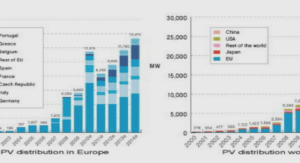Complexation de l’Eu(III) avec un acide fulvique étudiée par SLRT
La spéciation de l’europium a été étudiée par spectrofluorimétrie laser à résolution temporelle (SLRT) en présence d’un acide fulvique de Suwannee river (SRFA). Deux comportements de luminescence d’Eu(III) ont été mis en évidence à partir des isothermes de complexations construites pour différentes concentrations en Eu(III), valeurs de pH, forces ioniques et concentrations en SRFA. Dans la première partie des isothermes, à faibles concentrations en SRFA, on observe l’évolution classique de la luminescence de l’europium lors de la complexation par les substances humiques. Le ratio d’asymétrie entre les transitions 5D0→7F2 et 5D0→7F1 augmente jusqu’à atteindre un plateau et une décroissance de luminescence biexponentielle – avec un temps de vie très court de l’ordre de quelques µs et un second temps de vie plus long que celui d’Eu3+ – est observée. A de plus fortes CSRFA, un second mode de luminescence est mis en évidence où le ratio d’asymétrie continue d’augmenter après le plateau, ce qui peut être un signe de la formation d’un autre type de complexe, ou cela peut également refléter une organisation spatiale différente des complexes Eu-SRFA. Les temps de vie de luminescence continuent d’augmenter mais leur lien avec le nombre de molécules d’eau dans la première sphère de coordination de l’ion Eu3+ n’est pas simple du fait des mécanismes de quenching. L’évolution de l’environnement chimique de l’europium est également dépendante de la force ionique. Ces observations suggèrent qu’en plus d’interactions à courte distance – complexation intra-particulaire – il peut également y avoir des interactions à plus longue distance – répulsion inter-particulaire – entre les particules qui complexent l’europium aux fortes concentrations en SRFA. Ces interactions inter- particulaires ne sont pas prises en compte dans les différents modèles de complexation existants.
The use of rare earths, and particularly the lanthanides (Ln), is increasing in modern industry.1 Their importance in the understanding of geochemical processes, the presence of radioisotopes of lanthanides in spent nuclear fuels and radioactive wastes, and their analogy with some actinides (An) under the +III oxidation state, justify a better understanding of their environmental chemistry in waters, soils, and sediments. Humic substances (HS), mainly composed of humic (HA) and fulvic (FA) acids are one of the main component of aquatic and soil ecosystems and are known to play an important role in the binding and transport of trace metals such as Ln(III).2-4 Because of their strong interactions with surfaces5 and their colloidal properties,6 HS may affect Ln(III) either by distribution of groups of sites, e.g., NICA-Donnan.10 These kinds of models consider electrostatic phenomena, but the descriptions are somewhat different—hard sphere with a Donnan potential at the interface vs. permeable Donnan gel, respectively—when the structure of HS in general, and the structure of the Ln(III)-HS complexes in particular, remains largely under discussion.
Some Ln(III) and An(III) show a remarkable luminescence that is linked both to symmetry of their chemical environment,11 and to the amount of water molecules in the first hydration sphere.12,13 This information can be obtained both from the evolution of the luminescence varying.20,28 Time resolution of the luminescence signal, through time-resolved luminescence spectroscopy (TRLS), was used to obtain complexation constants as well as structural properties. The complexation strength of Ln(III) by HS can be considered relatively homogeneous within the series,29-31 in agreement with the strong proportion of oxygen containing functionalities of HS.30,32 Milne et al.33,34 proposed generic complexation data for Ln(III) and An(III) in the ͂ Mn+,i, for Am(III) and Cm(III), which is relatively surprising knowing the strong analogy between these two actinides(III), particularly regarding HS interactions.18 The correlation between NICA- Donnan parameters—Figure 1 of Milne et al.34—and the first hydrolysis constants of the the proposition of the formation of ternary complexes,20,36-40 which are not always necessary to interpret experimental data within the framework of NICA-Donnan23,25,41 or Model VI- VII,42-44 but was sometimes proposed nevertheless.39,40





